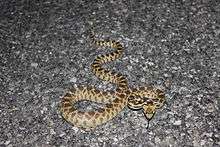Pituophis catenifer deserticola
The Great Basin gopher snake (Pituophis catenifer deserticola), also known as the bull snake,[1][note 1] is a subspecies of nonvenomous colubrid endemic to the western part of the United States and adjacent southwestern Canada.[2][3]
| Pituophis catenifer deserticola | |
|---|---|
 | |
| Scientific classification | |
| Kingdom: | Animalia |
| Phylum: | Chordata |
| Class: | Reptilia |
| Order: | Squamata |
| Suborder: | Serpentes |
| Family: | Colubridae |
| Genus: | Pituophis |
| Species: | |
| Subspecies: | P. c. deserticola |
| Trinomial name | |
| Pituophis catenifer deserticola Stejneger, 1893 | |
Geographic range
This snake can be found in the United States in Arizona, California, Colorado, Idaho, Nevada, New Mexico, Oregon, Utah, Washington, and Wyoming, and in Canada in British Columbia.[2]
Description
Adults of P. c. deserticola are usually about 4.5 feet (137 cm) in total length. The maximum recorded total length is 5.75 feet (175 cm).[4]
The Great Basin gopher snake has dorsal spots that are dark brown or black, and they are connected to each other by very narrow lines that run along each side of the anterior part of the body. On each side of the neck there usually is a dark longitudinal stripe that is surrounded by some lighter coloring, which eventually breaks up towards the posterior end of the snake and turns into dashes or small spots. The body scales are keeled, and the head has a pointed shape. The underbelly has a creamy color with small, dark, irregular blotches. There is some discrepancy over their average lifespan, the Utah Hogle Zoo reports the average lifespan is 7 years,[5] while others report that the average lifespan for the Great Basin gopher snake as being 12–15 years with the record age being 33 years and 10 months.[6]
| Scutellation | Usual # of scales |
|---|---|
| Midbody | 29–35 |
| Ventrals | 214–259 |
| Caudals | 54–71, divided |
| Anal | entire |
| Prefrontal scales | usually 4 |
| Supralabials | 8–10 |
| Infralabials | 9–15 |
| Preoculars | 1–2 |
| Postoculars | 2–6 |
Habitat
The Great Basin gopher snake can be found throughout the western United States in grasslands, woodlands, deserts, coastal sage scrub, agriculture land, and riparian areas.[8]
Behavior
The Great Basin gopher snake is a great climber, swimmer, and burrower. It is one of the most commonly found snakes when people are hiking or driving on the road. They are easily seen in spring when the male snakes are out and about trying to find a mate. The hatchlings are easily found in late August and September when they emerge from their eggs. Like most animals, Great Basin gopher snakes are not dangerous unless provoked. When defending themselves from predators, they will elevate and inflate the body, and flatten the head into a triangular shape. Loud hissing noises will ensue, along with quick shaking of the tail, mimicking the sound of a deadly rattlesnake. Unlike a rattlesnake, however, the Great Basin gopher snake is nonvenomous.[8]
Diet
The Great Basin gopher snake is carnivorous, and it preys upon a variety of organisms, including insects, lizards, birds and their eggs, and small mammals (pocket gophers).[6] Mammals are the most common prey item.[9]
Reproduction
Subspecies of gopher snakes lay their eggs from June to August, and the Great Basin gopher snake is no exception. After the sexually mature snakes mate in spring, the females usually lay 3-24 eggs, with 7 eggs being the average. It usually takes the eggs 2 to 2.5 months to hatch. When the young emerge, they are usually in the range of 30–46 cm (12–18 in) in total length.[5]
Notes
- Not to be confused with the bullsnake, another subspecies of gopher snake.
References
- "Living with Wildlife – Snakes" (PDF). Washington State Department of Fish and Wildlife. Retrieved July 1, 2019.
- "California Herps". Retrieved 2009-10-04.
- Pituophis catenifer at the Reptarium.cz Reptile Database. Accessed 25 February 2019.
- Schmidt, K.P., and D.D. Davis. 1941. Field Book of Snakes of the United States and Canada. G.P. Putnam's Sons. New York. 365 pp. (Pituophis catenifer deserticola, pp. 165-166 + Figure 46. on p. 161.)
- "Utah's Hogle Zoo". Retrieved 2009-10-03.
- Shannon Hiatt. "General Care of the Baja California gopher, Pacific gopher, and Great Basin gopher snakes". The Pituophis Page. Retrieved 2009-10-06.
- "World Pituophis Web Page". Retrieved 2009-10-04.
- "Zipcode Zoo". Archived from the original on 2012-06-12. Retrieved 2009-10-05.
- Rodríguez-Robles, Javier A. (2002). "Feeding ecology of North American gopher snakes (Pituophis catenifer, Colubridae)". Biological Journal of the Linnean Society. 77 (2): 165–183. doi:10.1046/j.1095-8312.2002.00098.x.
Further reading
- Stejneger, L. 1893. Annotated List of the Reptiles and Batrachians Collected by the Death Valley Expedition in 1891, with Descriptions of New Species. North American Fauna (7): 159-228. ("Pituophis catenifer deserticola, subsp. nov.", pp. 206–208.)